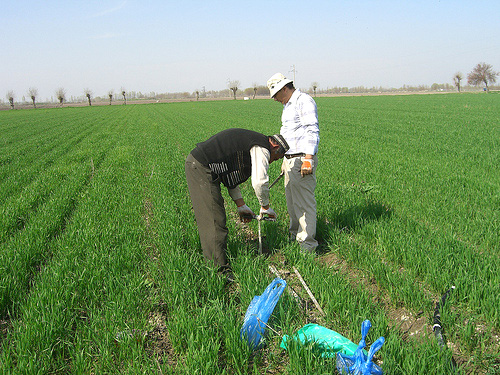Second Expedition of ZEU and SIC ICWC specialists to Fergana Valley
Scientists from ZEU and SIC ICWC had their second expedition in the frame of the CAWa project to Fergana valley in March 2010. The field works are carried out to assess the water use efficiency and quantify the amount of evaporating groundwater – which is lost for productive use.
Scope of Works
The first field campaign of Workpackage 3 for 2010 started in March in Fergana Valley. Scope of the work is to analyse and quantify regional water use efficiency under the current land use and irrigation management. The results shall be used to improve regional water use management. The measurements comprise regular soil moisture analysis, piezometer and discharge measurements. Data will be collected throughout the vegetation period 2010. To quantify evaporation from groundwater, soil samples for soil water isotope analyzes have been taken on a winter wheat site.
A soil moisture monitoring system and piezometers were installed on field sites in the Fergana Valley. Furthermore, the amount of irrigation on the field level will be monitored. Selection of fields and set-up of the experiments was jointly conducted by the project partners of SIC ICWC. Measurements will take place on winter wheat and cotton fields in WUA Akbarabad and Azizbek.
Current Status and Expected Results
Currently, the set-up of the soil moisture measurement grid has been completed for the winter wheat and cotton sites, and first soil moisture measurements took place. Furthermore, three piezometers per site have been installed. Soil water isotope analysis will take place at the extraction laboratory at the Institute of Resources Management/Giessen University. First results of the soil water measurements and the isotope measurements are expected by end of May and the results will be used to adjust and further improve the sampling strategy on the experimental sites.
The soil water isotope profiles will be compared with profile data taken in 2009. Results indicate high amounts of evaporation which is fed by groundwater. Phreatic evaporation increases with higher groundwater levels (approx. 0.6 m evaporation per year when groundwater level is < 2 m from surface). Although the results have to be confirmed by further studies in 2010, the data indicate that groundwater level as subject to irrigation management considerably influences the amount of “unproductive” evaporation.
For details please contact:
Dr. Katrin Schneider
Centre for International Development and Environmental Research (ZEU)
University of Giessen
Phone: +49 641 9937394
Email: Katrin.schneider@umwelt.uni-giessen.de
Опубликовано Katy Unger-Shayesteh в
